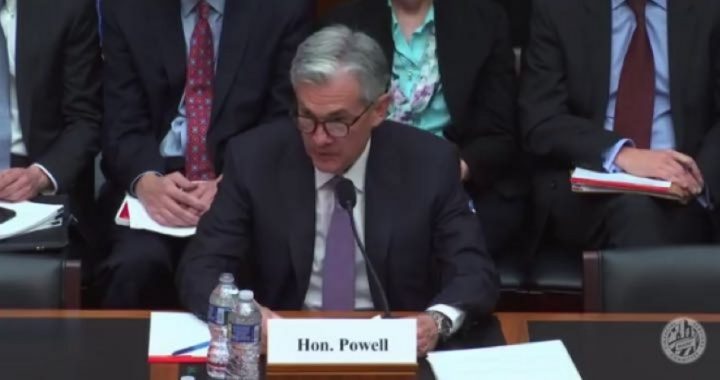
Jerome Powell (shown), chairman of the Board of Governors of the Federal Reserve System, addressed the House Committee on Financial Services on February 27, presenting the Federal Reserve’s semiannual Monetary Policy Report to the Congress. The stock and bond markets reacted to Powell’s hints that the Fed may raise interest rates in the months ahead.
It was Powell’s first congressional appearance since becoming chairman of the Federal Reserve on February 5.
Powell told the Financial Services Committee that “the economic outlook remains strong,” despite recent financial market volatility.
A report on Powell’s appearance from NPR observed that the new Fed chairman said the Federal Reserve remains on track to continue increasing interest rates gradually to keep the economy functioning smoothly.
Powell noted that “fiscal policy is becoming more stimulative” — an apparent reference to the Trump administration new tax-cutting law — and he predicted inflation would rise this year and stabilize near the Fed’s two-percent target. “My personal outlook for the economy has strengthened since December,” Powell told the committee.
Speaking on the “Current Economic Situation and Outlook,” Powell noted that the U.S. economy “grew at a solid pace” over the second half of 2017 and into this year. He said that monthly job gains averaged 179,000 from July through December, and that payrolls rose an additional 200,000 in January. He continued:
This pace of job growth was sufficient to push the unemployment rate down to 4.1 percent, about 3/4 percentage point lower than a year earlier and the lowest level since December 2000. In addition, the labor force participation rate remained roughly unchanged, on net, as it has for the past several years — that is a sign of job market strength, given that retiring baby boomers are putting downward pressure on the participation rate. Strong job gains in recent years have led to widespread reductions in unemployment across the income spectrum and for all major demographic groups.
Powell elaborated on the figures for those demographic groups, which included adults without a high school education (down from about 15 percent in 2009 to 5-1/2 percent in January of this year), those with a college degree (down from five percent to two percent over the same period). African Americans and Hispanics (at or below pre-recession rates).
The Fed chairman also noted that the inflation-adjusted gross domestic product rose at an annual rate of about three percent in the second half of 2017. He observed that this was one percentage point faster than its pace in the first half of the year.
Any comments from the Fed chairman about inflation are sure to create heightened interest among observers, since the Federal Reserve makes a point of adjusting interest rates according to the inflation rate, either to stimulate economic growth through lower interest rates or to hold down prices through higher rates. (During his talk, Powell stated: “In gauging the appropriate path for monetary policy over the next few years, the FOMC [the Federal Open Market Committee] will continue to strike a balance between avoiding an overheated economy and bringing PCE price inflation to two percent on a sustained basis.”)
Whenever a Fed official or most economic reporters use the term “inflation,” however, it is important to remember (as another writer for The New American recently observed):
Properly defined, inflation is an increase in the money supply, with price increases being the natural inevitable result as each piece of currency becomes less valuable over time. And only the Fed increases the supply of money. (Counterfeiters would be the only exception, to whom the Fed is often compared.)
In that article, “Inflation Concerns Unfounded, Wall Street Moves Higher,” written just two weeks ago, writer Bob Adelmann, a former investment advisor, reported that once Wall Street traders read beyond the headlines released on February 14 by the Bureau of Labor Statistics (BLS), they reversed an early sell-off in stocks and bid the market higher. Adelmann noted:
Those traders were on high alert following the January report that wages had jumped nearly three percent last year. This triggered concerns that inflation was imminent, and that the Fed would institute interest rate increases which would slow the economy.
As Powell addressed the House Financial Services Committee, not only traders, but all those following our nation’s economic state, were again on high alert, hanging on Powell’s every word to see if he would provide a hint concerning the Fed’s plans to raise interest rates during the coming year.
Powell said individual Fed members will be crafting new projections at the central bank’s meeting in March, and those projections would be influenced by federal government’s ambitious fiscal policies including tax cuts.
But the talk of a slight rise in the interest rate did not cause a panic in the stock market. “I think [the stock] reaction to his comments about slightly strong growth and that the Fed was more likely to raise rates more in 2018 than investors had anticipated,” CNBC quoted Kate Warne, an investment strategist at Edward Jones. “You saw some reaction, but not a dramatic one. Investors have become increasingly comfortable that if rates continue to rise slowly in response to economic growth, that’s a good thing.”
Reporting about the impact of Powell’s comments on the investment markets, John Ydstie, of NPR News, observed:
Inflation has been running below the 2 percent level the Fed believes is best for the economy. But investors saw something to worry about in Powell’s sunny comments. They thought it made it more likely the Fed will increase rates faster. Right now the Fed has signaled three quarter-point rate hikes for 2018, the first likely to come at the next Fed meeting in March. Futures markets showed the odds of a fourth rate hike rising in response to Powell’s comments. Stocks, which benefit from lower rates, fell sharply today, while interest rates rose in the bond market.
Image: Screenshot from youtube video by GOP Financial Services
Related articles:
Powell, Taylor, El-Erian: Trump Sets Up Another CFR/Globalist Sweep of Top Fed Posts
Trump’s Establishment Pick for Fed Chair, Jerome Powell, Won’t Rock the Boat
Inflation Concerns Unfounded, Wall Street Moves Higher
Treasury Advisory Committee Says U.S. Must Borrow Trillions, Sending Stocks Down
Americans Expect Booming Economy to Continue, Says Conference Board
Markets Move Higher Following Crash Instigated by Obscure Agency



